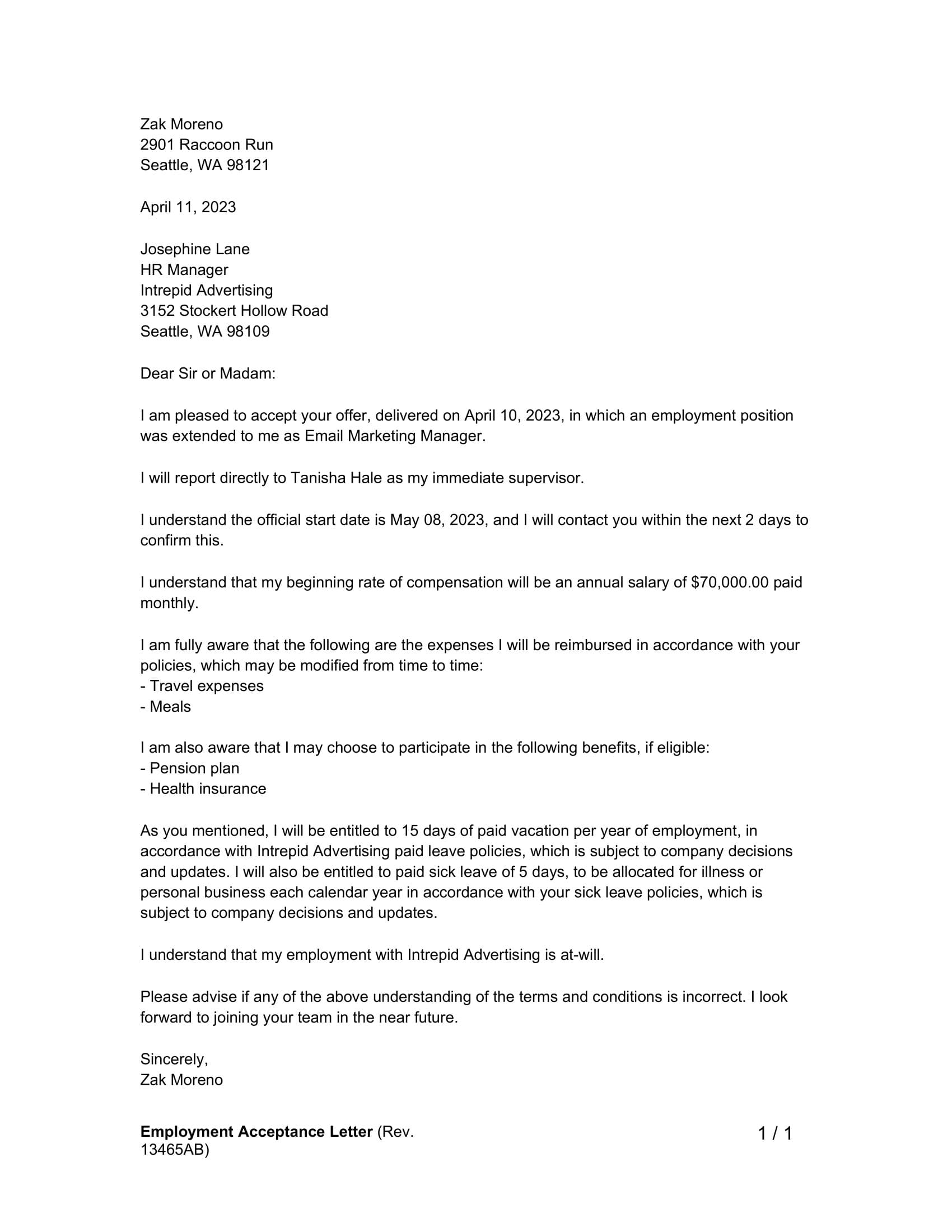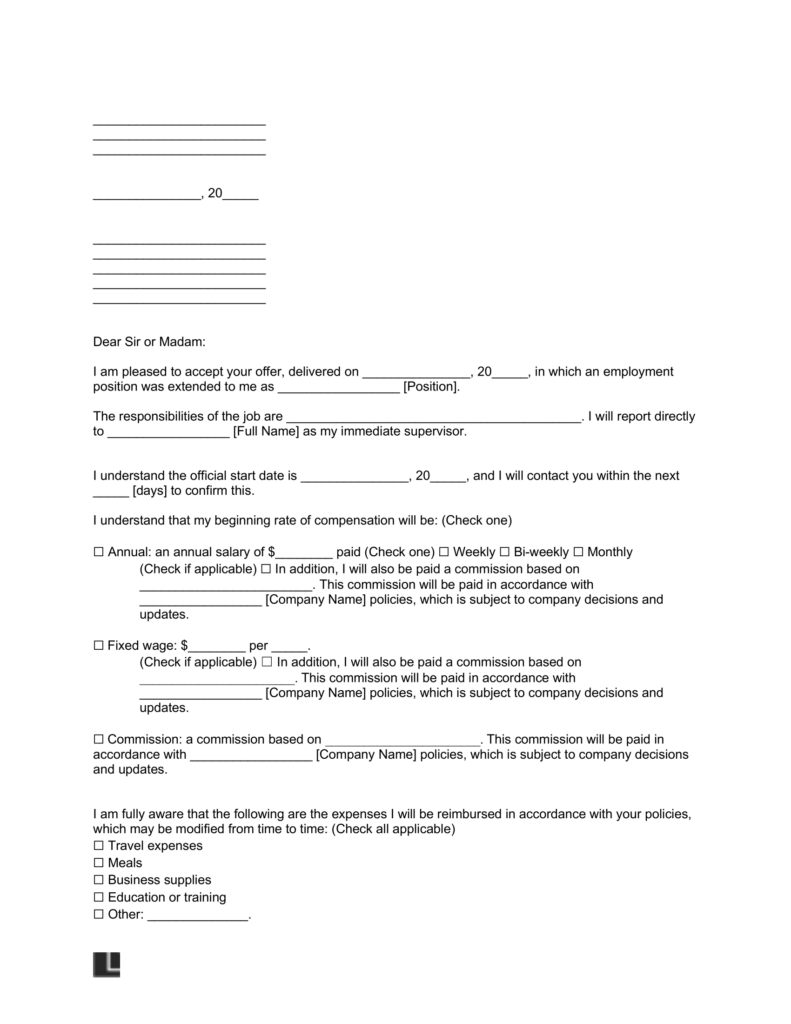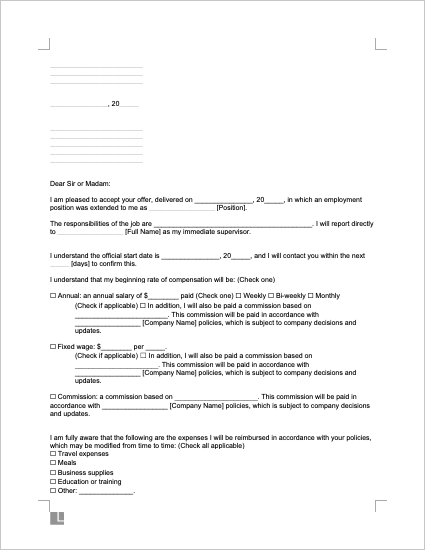A Job Acceptance Letter is a letter written by the employee to accept a job offer. It is an essential document that helps you start your employment on the right foot and with clear expectations.
The letter reassures the company that they’ve made a good hiring decision and also provides you with an opportunity to express your gratitude for the job offer. This article will guide you on what a job acceptance letter should contain and how to write one.
How to Accept a Job Offer
When you get a job offer, please don’t rush to accept it.
- Take some time and carefully read the terms of employment before you decide to either accept, decline, or negotiate the terms as you desire.
Make sure you’re satisfied with the terms of employment, including:
-
- The salary
- Any bonuses or commission schemes
- Company benefits such as gym membership, private health care, or discounts
- The job title
- What your working hours will be, and if you can work flexibly
- Where will you work, and is there a remote work policy
- Ask any final questions if there’s anything unclear, and don’t be afraid to negotiate if you’re not happy with anything in the initial offer. There’s often some flexibility in a job offer.
- If you accept the job offer, communicate it in writing with a job acceptance letter. An acceptance letter allows you to express your gratitude for the job offer, clarify your terms of employment, and officially designate your start date.
You should submit an official job acceptance letter even if you accept the job offer verbally.
How Long Can You Take to Respond to a Job Offer?
It’s within your power to ask for a reasonable time to consider the job offer. A week is regarded as an excellent time to make a decision.
Some hiring managers want to put you under pressure to accept their job offer as soon as possible. But sometimes, you need time to consider other factors before making an informed decision.
Some job offers may ask you to respond within 2-3 working days. While you can ask for an extension, it’s professional to get back to the hiring manager within 24 hours whether or not you intend to accept the job. This way, you can maintain your candidacy while waiting to decide. However, if a job is your first choice and you’ve decided to go for it, there’s no need for delay.
Remember, a job offer is usually not binding. The aim is to provide successful applicants with enough information on the terms of their proposed employment so they can decide to accept or decline the job offer. A job only becomes yours when you have signed an employment contract.
How to Write a Job Acceptance Letter
Follow these steps to write a job acceptance letter:
Step 1 – Include the Appropriate Addresses
A job acceptance letter is essentially a letter; you should address it adequately. Even though your employer may already have your contact information, you should still include them in your letter.
Also, make sure you address the letter to the appropriate party. The right person may be the hiring manager or your direct supervisor.
TIP
Use the right format – an acceptance letter is a business letter, so it usually follows a format. Always include your contact information and phone number.
Whether you email or mail, ensure your letter has the right structure.
Step 2 – Express Your Gratitude For the Offer
Say how grateful you are for the opportunity to pass through the interview process and be invited to work with the company. This is also the time to show enthusiasm for the role and the accompanying responsibilities.
What are you most thrilled about in your new employment? Why are you excited about working with the company? Are you glad to work with a company whose mission statement aligns with your life’s goal? Or maybe you’re eager to take on responsibilities that will stretch and push you to grow in your career. Go ahead and say it.
TIP
Keep it professional – When writing an acceptance letter, you want to project yourself as a professional. This is not the time to be funny and try to crack jokes. Not everyone appreciates jokes, and your sense of humor may not be received well. Remember, you don’t know the addressee. Please don’t give your employer a reason to question their hiring decision.
Step 3 – State and Agree With the Terms of Employment
Summarize and list the terms you and the employer have agreed upon briefly. State that you accept the job and recap the compensation — salary, benefits, title, and paid time off — as you understand them.
If some things are unclear, ask for further clarification before accepting the job. Also, if there are parts of the offer you are uncomfortable with and want to negotiate, do so before sending in your job acceptance letter.
Step 4 – Indicate Your Start Date
State the date you will be ready to start working. If you need more time before starting, you can ask your employer to extend your start date.
Step 5 – Sign the Letter
Close the acceptance letter with an official complimentary close, like “Sincerely,” “Best Wishes,” or “Best Regards.” Append your signature and write your name.
Sometimes, you could be at a loss on how to write your acceptance letter — the proper structure, what to include, what to leave out, and the right tone and expression. You can avoid the hassle and write your acceptance letter using a template. Legal Templates can help you write a professional acceptance letter that ticks all the boxes in minutes.
TIP
Proofread and edit – Before you turn in your acceptance letter, take some time to read it over again and try to spot any grammar, punctuation, or spelling errors. Your acceptance letter is often your first written communication with your employer after they have decided to bring you on board. Double-check to ensure you spelled the company name and the name of the person offering you the job correctly.
Things To Consider After Accepting a Job Offer
Once you’ve formally accepted the job offer, you’ll want to start finalizing things with your former employer and preparing for your first day at your new job. Hand in your notice in line with your existing employer’s policy, and then:
- Formally accept the job offer, probably sent using a job offer letter and outlining a proposed start date.
- Read and sign any documents the new employer sends, such as an employment contract, work-from-home policy, or vaccination policy.
- Clear any final steps, such as obtaining references or assisting with background checks.
Your new employer will be keen to help you wherever they can, so if you have any questions about your employment, then you should reach out.
Example

Sample Job Acceptance Letter
Below is a standard job acceptance letter you can download in PDF or Word format:



